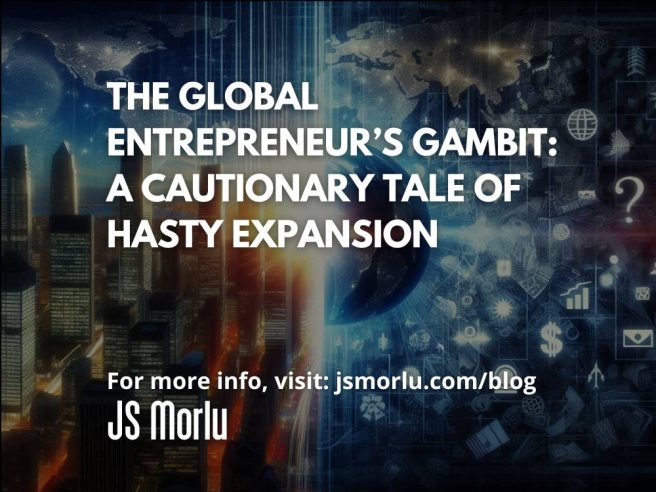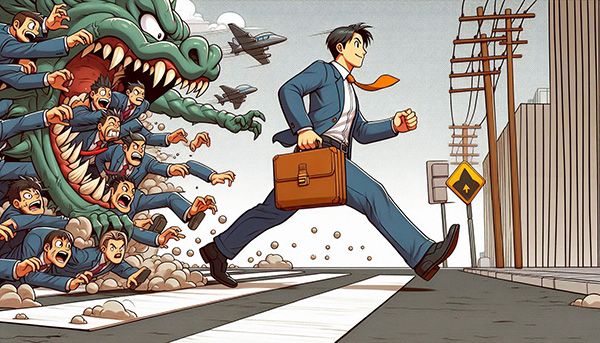By: John S. Morlu II, CPA
Introduction
In today’s hyper-connected world, the allure of global expansion gleams irresistibly for ambitious entrepreneurs. The idea of tapping into vast new markets, unlocking diversified revenue streams, and harnessing the brilliance of a global talent pool seems like the ultimate reward for years of hard work. For many, going global represents not just an opportunity but the pinnacle of business achievement—a glittering trophy symbolizing their transition from a local player to a worldwide powerhouse. The promise of international success, wrapped in potential profits and boundless opportunities, is often too enticing to resist.
But like all things that glitter, this path can be deceiving. Beneath the surface, hidden behind the promises of increased revenue and global recognition, lie a web of complexities that can ensnare even the most capable entrepreneurs. Regulations differ drastically from one country to the next; cultural norms, business etiquette, and customer expectations can be worlds apart. And yet, in the rush to claim their piece of the global market, too many entrepreneurs overlook these crucial details, assuming that what worked at home will seamlessly translate abroad. This assumption is not just risky—it can be catastrophic.
The story of Mr. Smith is a perfect example of how quickly dreams of global domination can turn into nightmares when due diligence is sacrificed in the name of ambition. His tale is one of optimism and opportunity, but also of oversight and failure. It serves as a stark reminder that expanding into foreign markets requires more than just bold vision and ambition; it demands meticulous planning, an understanding of local laws and customs, and a willingness to adapt. Without these elements, the global stage, instead of delivering success, may just as easily deliver a cautionary tale.
Chapter 1: The Leap into the Global Market
Our story begins with a small business owner, Mr. Smith, who had built a moderately successful enterprise in his home country. Flush with the confidence that comes from years of steady growth, Mr. Smith began to feel that his success could be replicated anywhere. Encouraged by the advice of well-meaning friends and business consultants, he decided it was time to take his business to the global stage.
Mr. Smith had heard stories of entrepreneurs who had made fortunes by expanding into untapped markets. These stories filled his mind with visions of wealth and prestige, of bustling offices in exotic locales, and of a workforce so talented that his business would soon become a global powerhouse. The potential for growth seemed limitless, and the risks, well, those were just minor details.
Chapter 2: The Setup: A Small Country with Big Surprises
Eager to make his mark, Mr. Smith hired a top-notch lawyer who specialized in international business. Together, they scoured the globe for the perfect location. After much deliberation, they settled on a small country that barely registered on most maps. The country was picturesque, with a relatively low cost of living, and, most importantly, a business-friendly environment—or so it seemed.
Mr. Smith, confident in his lawyer’s abilities, signed the necessary paperwork and set up his new business. He didn’t bother with the finer details, like understanding local labor laws or cultural expectations. After all, how complicated could it be? Business was business, and success would surely follow.
Chapter 3: The Hiring Spree
With his new venture set in motion, Mr. Smith embarked on an aggressive hiring spree, determined to assemble a world-class team. He wanted the best talent money could buy, and he found it. His team was diverse, dynamic, and on paper, everything he had envisioned. Among his new hires were eight young women, all enthusiastic and eager to contribute to the company’s success. Mr. Smith had always been a firm believer in gender equality, convinced not only that hiring women was the just and fair thing to do, but that women often outperformed men in the workplace. When he read that local laws required at least 50% of the workforce to be women, he felt a sense of validation. Not only was his philosophy in line with the law, but it appeared that he was ahead of the curve in this new market.
However, what seemed like an ideal situation soon turned into a complex challenge. While Mr. Smith had satisfied the legal requirement for gender parity, he had failed to consider the broader implications of local labor laws. These laws extended far beyond gender quotas and encompassed intricate regulations regarding working hours, maternity leave, and protections for women in the workplace. The very policies that seemed to support his hiring approach now presented operational headaches he hadn’t anticipated.
As the days went by, the reality of his oversight became clear. Compliance with these laws demanded more than simply meeting gender ratios; it required a detailed understanding of labor rights, employee benefits, and the cultural expectations around work-life balance. Mr. Smith soon realized that his well-intentioned efforts to build a diverse and equitable team were hindered by his lack of preparation, turning what should have been a triumph into yet another lesson in the importance of due diligence.
Chapter 4: The Unseen Obstacles
Barely two months into operations, Mr. Smith received the first of what would become a series of shocks. Five of his newly hired female employees approached him with news: they were pregnant. Under the laws of this small country, pregnant women were entitled to extensive maternity leave. Not just a few months, but an entire year. And during this time, they were to be paid in full.
Mr. Smith was stunned. But the surprises didn’t stop there. When these women returned to work, they would only be required to work four hours a day for an entire additional year. Moreover, he would need to provide them with a private space for prayer and breastfeeding, forty times a week. Mr. Smith’s attempts to negotiate or find a loophole were met with stern reminders that the law was the law, and any attempt to dismiss these employees would result in a mandatory payout of six months’ salary.
As Mr. Smith sat in his now-bustling office, it dawned on him that he was essentially running a daycare and maternity ward rather than a business. His team was rapidly becoming non-productive, yet his payroll costs remained as high as ever.
Chapter 5: A Cascade of Complications
The situation continued to spiral out of control for Mr. Smith. What had initially seemed like a strategic move for global expansion was now a minefield of complications. As he dug deeper into the local laws, the entrepreneur discovered a web of regulations that would have given any seasoned business owner pause. The country he had ventured into, it turned out, was a bastion of worker rights, with employee benefits that bordered on the absurd.
Initially, the fact that workers were entitled to a staggering 45 days of holidays each year, coupled with a mandatory 30 days of vacation and 15 days of sick leave, was already enough to cause concern. But the further he delved into the fine print, the worse it became. The realization that his staff could be out of the office for over three months annually without any reduction in pay hit him like a sledgehammer. He was facing the grim reality of running a business in a place where productivity was seemingly an afterthought.
Chapter 6: The Lineup of Unproductive Workdays
As Mr. Smith read further into the labor laws, the full scale of his predicament came into focus. The following list of mandated days off and workplace regulations read more like a satire of a functional business environment:
- Family Medical Leave (6 months): Workers were entitled to six months of paid family medical leave. The catch? In this tightly-knit society, everyone seemed to be related, and family illnesses were an everyday occurrence. Productivity suffered as people constantly took time off for a “sick aunt” or “cousin’s cousin,” without the possibility of verification.
- Christmas (2 weeks): From December 15th to January 6th, the entire country came to a standstill. Mr. Smith’s business essentially closed for the last two weeks of the year, putting any end-of-year projects or goals completely out of reach.
- Easter (1 week): The week-long celebration left the office empty, while projects sat untouched for days.
- Ramadan (1 week): Despite the population being 95% Christian, the country still observed a full week for Ramadan, creating another unexpected and unnecessary halt in operations.
- Chinese New Year (2 days): Celebrating a holiday for a demographic that amounted to only half a dozen people in the entire country felt ridiculous, but the law mandated it.
- Hindu Festival (1 week): A week-long celebration for the 200 Hindu worshipers in the country made Mr. Smith question whether holidays were awarded based on population size or political correctness.
- Buddhist Celebration (1 week): With only 50 Buddhists in the country, this holiday made even less sense, but nonetheless, employees were given the week off.
- Sikh Celebration (1 week): Astonishingly, a week off was given to honor the only Sikh worker in the entire country.
- Yom Kippur (1 day): For the 600 Jews in the country, this day of reflection also halted business for those who observed.
- 45-Minute Rest Time: In addition to the standard 1-hour lunch break, workers were entitled to an extra 45-minute rest period, plus two 15-minute breaks—all totaling a workday where actual productivity dwindled down to a handful of hours. Mr. Smith found it reminiscent of Japan’s famous break periods, but without the work ethic that balanced them.
- “Bring Your Child, Friends, Neighbors, and Pets to Work” Days: As if the myriad holidays weren’t enough, employees were encouraged to disrupt the already low productivity by bringing their extended family, friends, and even pets to work, leading to chaos in the office environment.
- Legislation in the Works: 4-Hour Workday, 3-Day Work Week: As if the current situation wasn’t crippling enough, a new law was being considered that would reduce working hours to 4 hours a day, 3 days a week, with no reduction in pay. Mr. Smith’s hopes of ever seeing consistent productivity seemed more and more like a fantasy.
- Bereavement Leave (20 days): Deaths, unfortunately, happened often in large families, and the entire country seemed to be related. Employees were entitled to 20 days of paid bereavement leave, and with the frequency of extended family deaths, it seemed like someone was always out of the office grieving.
- 10 Personal Days to Bake on the Beach: Workers were entitled to 10 additional personal days to “rest and recuperate,” which often translated into spending time baking under the tropical sun while deadlines slipped further away.
Chapter 7: The Fallout: A Business Model in Shambles
Mr. Smith’s business model, finely tuned to the competitive environment of his home country, was now in ruins. The productivity he had once relied on was nowhere to be found. Every time he tried to get a project moving, half of his staff seemed to be out on some form of leave, whether for religious holidays, sick relatives, or simply soaking up the sun. Meetings were perpetually rescheduled, deadlines were missed, and clients—those who had once eagerly signed contracts with him—began to lose faith in his ability to deliver.
Each setback compounded the frustration. With deadlines slipping and expenses rising, Mr. Smith’s operational costs began to balloon. The overhead of paying salaries to employees who were on various types of leave, combined with the need to hire temporary workers to cover the gaps, ate into his bottom line. His dream of growing a thriving global business now seemed like a bureaucratic nightmare that would bleed him dry.
Chapter 8: No Exit in Sight: The Stranglehold of Local Laws
Firing employees, though incredibly tempting, was simply not an option for Mr. Smith. The country’s labor laws were so stringent that any attempt to downsize would have left him financially crippled. Severance packages alone could bankrupt his business, with some employees entitled to up to six months’ salary if they were let go. At that point, firing someone wasn’t just a personnel decision—it was a full-blown heist, where Mr. Smith was the one getting robbed.
Worse yet, the social stigma surrounding firing workers in this country was intense. The mere rumor of a termination could have sparked protests, boycotts, and Mr. Smith being branded as the heartless foreigner who came to ruin the local economy. It was the sort of scandal that no amount of PR spin could fix. His name would be whispered in coffee shops and spit out with disdain on the local radio. One wrong move, and he could kiss what little goodwill he had left goodbye.
And don’t even think about winning in court. The government had set up an entire judicial system just for labor disputes—The Tribunal—where the country’s best lawyers worked diligently… for the government. It was less of a fair trial and more of a predetermined sentencing. There wasn’t a shred of evidence that an employer had ever won a case. The Tribunal was designed with one mission: to make sure any business owner who dared to defend themselves against a worker grievance would end up broke and humiliated. Some whispered that the Tribunal’s motto was secretly “Guilty until bankrupt.”
It got so bad that business owners were fleeing the country under the cover of darkness, abandoning their assets and never looking back. If you took a late-night stroll near the airport, you might catch a glimpse of panicked CEOs sprinting to catch the last flight out of Dodge, suitcases packed with nothing but cash, credit cards, and their dignity (what was left of it, anyway).
In the end, the irony was rich: when these employers fled, their companies collapsed, and the very employees the government was trying to protect found themselves jobless. So much for workers’ rights.
Chapter 9: The Never-Ending Hiring Trap
Even hiring new employees was a bureaucratic nightmare. The laws required that before onboarding anyone, the employer had to subject them to a thorough medical exam, a psychological evaluation, and a never-ending list of tests that made a space mission seem casual. You had to make sure they were fit for work, mentally stable, and, for all you knew, not secretly plotting to leave the company after they’d milked all the paid vacation days.
Naturally, this wasn’t an option for most employers—the costs were astronomical, and the process took so long that by the time you’d hired someone, they’d probably already qualified for retirement. But no sooner had employers found a workaround than the Medical Association saw its own golden opportunity. They lobbied the government to make these tests mandatory, conveniently forgetting to mention that the costs would, of course, be borne by the employers. Now, not only were businesses being squeezed dry by employees, but doctors were lining up at the trough as well.
The system was rigged from every angle. Between The Tribunal and the Medical Mafia, Mr. Smith felt like a piñata at a never-ending party where the goal was to see how much he could lose before collapsing. Global expansion? He was lucky if he could just make it to the end of the week without getting sued, fined, or forced into another “Bring Your Neighbor and Pets to Work” day.
In short, Mr. Smith had found himself in a Kafkaesque nightmare where running a business wasn’t about growth, innovation, or profit. No, it was about survival, and even that seemed increasingly unlikely.
Chapter 10: The Cry of Despair
Sitting in what was once a pristine office but now felt more like a war room, Mr. Smith could only stare blankly at the mounting paperwork, labor law manuals, and endless government notices strewn across his desk. The grand vision of global dominance that had once fueled his ambition had crumbled like a house of cards in the wake of a bureaucratic tsunami. How had things gone so terribly wrong? Where had his dream, his empire of international success, turned into this never-ending nightmare?
The answer lay, as it often does, in his own hubris. Mr. Smith had believed that his success back home—his tightly run, efficient business model, which had earned him praise and profit—would seamlessly translate across borders. After all, business was business, right? He had assumed that if he hired a top-notch legal team, they would handle all the details while he focused on growing his brand globally. He had assumed that the business strategies that had served him well in his home country would work just as well in this small, barely-on-the-map nation.
What he hadn’t accounted for were the endless complexities of doing business in a foreign land—a country with unique labor laws, a fierce sense of worker rights, and cultural expectations that turned his carefully laid plans into a bureaucratic quagmire. Due diligence? He had skipped it. Understanding local laws and customs? That had seemed like a minor footnote in the grand plan of making millions.
As it turned out, these “minor footnotes” had grown into full-blown monsters that were now threatening to devour his entire business.
Every day, Mr. Smith faced a new challenge. One day it was a labor regulation about mandatory breaks and prayer times, the next it was a mandatory psychological evaluation for every new hire. Every time he thought he had found a loophole or a workaround, another law popped up—like some malevolent game of legal Whack-a-Mole. The employees he had once counted on to be the backbone of his global operation were now an unproductive mob of absentee workers, on leave for every conceivable holiday, religious festival, or family medical issue. He had never dreamed that labor laws could be so, well… thorough.
His frustration grew as the vacation days, sick leave, and bereavement allowances piled up. How was he supposed to run a business when half his team seemed to be on perpetual leave, baking in the sun on their mandatory 30 vacation days or mourning the loss of a distant relative—again? And firing them? Forget it. With the country’s six-month severance pay rule, even attempting to trim his workforce would have left him bankrupt faster than you could say “global expansion.”
Chapter 11: A Monumental Misstep
It wasn’t just the labor laws that stung—it was the realization that he had walked into this with his eyes half-shut. He had charged into this new market, armed with little more than optimism and the belief that his team could handle whatever challenges arose. But no legal team, no matter how skilled, could prepare for the onslaught of local customs, cultural expectations, and legal pitfalls that awaited him.
The truth was, Mr. Smith had vastly underestimated the importance of local knowledge. He had dismissed the idea of understanding the workforce and local employment practices, brushing it off as unnecessary when compared to the promise of tapping into global talent and expanding his brand. But here he was, paying the price for that arrogance. The allure of “going global” had blinded him to the realities of globalization—namely, that every country is its own maze of laws, cultures, and expectations, and failing to respect that would be the quickest path to ruin.
The headaches were now constant companions. He was surrounded by the bitter fruits of his neglect—unfamiliar regulations, endless government notices, a dwindling bank account, and a growing sense of helplessness. He had walked into a minefield without bothering to read the map, and now he was standing in the wreckage of his once-promising business.
Chapter 12: Hubris: The Silent Killer of Business
Mr. Smith’s tears of frustration were not just the result of financial losses—though those were considerable. They were the product of crushed pride. He had believed that his success, his ability to “make it” back home, meant that he could conquer new markets without bothering to do his homework. But the truth was simple: hubris is a killer.
He had failed to account for the fact that while globalization offers opportunities, it also comes with its own unique set of challenges. Mr. Smith had ignored the most basic principle of business expansion: know the market. Know the laws, the people, the culture, and—perhaps most importantly—the workforce. Failing to do so was like trying to play chess without knowing the rules.
In this new country, the rules were stacked against him from the start, but he had walked into the game without even bothering to learn them. And now, as he stared at the mountain of unpaid invoices, delayed projects, and legal notices, he could see clearly where it had all gone wrong.
Chapter 13: The Price of Ignorance
The promises of global expansion—wealth, access to international talent, and brand prestige—had evaporated, replaced by a bureaucratic swamp that was slowly suffocating his business. Instead of reaping the rewards of his global venture, he found himself tangled in a web of unforeseen regulations and productivity-sapping labor practices.
In the end, Mr. Smith wasn’t just fighting to survive in a foreign market—he was fighting against his own arrogance. The arrogance that had made him believe that the world was his for the taking, that the business practices of one country could be copy-pasted onto another without consequence. He had ignored the value of cultural sensitivity, local expertise, and an adaptable business model, and he was now paying the ultimate price.
As he sat in his office, the realization dawned on him: global expansion isn’t just about opportunity—it’s about understanding. Understanding the laws, the people, and the nuances of the market. It’s about humility, the willingness to learn, and the wisdom to respect the complexity of different countries. And as much as Mr. Smith hated to admit it, he had missed the mark on every count.
The tears of frustration flowed freely now. They were the price of his hubris, and as he faced the reality of his crumbling business, he knew he had only himself to blame. Global success wasn’t just about ambition—it was about preparation, and Mr. Smith had walked into the lion’s den with neither a plan nor a way out.
Chapter 14: Lessons Learned (Too Late)
Mr. Smith’s saga is a hilarious, yet painfully poignant reminder to all globe-trotting entrepreneurs who dream of conquering foreign markets. Sure, the world may seem more connected than ever, and global expansion might sound as thrilling as it does profitable. But let’s get one thing straight: “one size fits all” only works in the world of socks, and business is definitely not socks.
What works in one country—where maybe you can casually fire someone after lunch and be hailed as a tough, decisive leader—might land you in court faster than you can say “severance package” in another. For Mr. Smith, the dream of global dominance quickly became a very expensive lesson in humility. And by expensive, we mean lawyer’s-fee-expensive, and severance-payment-expensive—the kind of expensive that makes you consider taking up artisanal pottery in a remote village just to avoid the bill collectors.
Had Mr. Smith taken just a little more time to research, he might have discovered that labor laws in his new playground were less “business-friendly” and more “business-strangling.” Firing an employee? Sure, but make sure you’re prepared to send their kids to college with the mandatory six months’ severance. Not doing so could result in a Tribunal showdown with a team of government lawyers who clearly went to law school for the express purpose of demolishing people like you.
But let’s be honest: It wasn’t just the labor laws. It was the cultural blind spots. You can’t just waltz into a new country, thinking your business brilliance will light the path to success, especially when you have no idea what those unspoken social rules are. Think you’re going to shake up the hiring process with cutting-edge psychological testing? Good luck, because the medical association was just waiting for you to skip that costly step so they could get a slice of the lawsuit pie too.
Chapter 15: The Myth of the “Plug-and-Play” Business Model
Mr. Smith had, in fact, fallen into the classic entrepreneurial trap—the myth of the “plug-and-play” business model. Back home, things had been a breeze. There were no cultural landmines to tiptoe around, no bewildering local customs, and certainly no Tribunal armed to the teeth with the best lawyers in the land. But in this new, strange business world, it was like someone handed him a board game with no rules, told him to roll the dice, and—oh, by the way—he’s already losing.
Before embarking on his ill-fated global adventure, Mr. Smith had convinced himself that hiring the best lawyers would be enough to safeguard his dreams. What he hadn’t realized was that even the most brilliant legal minds couldn’t protect him from the cultural and regulatory booby traps he was about to step on. No lawyer could explain why the entire workforce seemed to disappear for religious holidays that lasted weeks. No legal advice could anticipate the sheer volume of required documentation for even the simplest of tasks, or the absurd medical tests demanded by local law before hiring anyone.
Mr. Smith thought that as long as his legal team had his back, he could walk into this new market with swagger and leave with profits. But swagger, it turns out, doesn’t hold up well in front of a labor court judge.
Chapter 16: Global Expansion: Not for the Faint of Heart
Expanding globally is not a game for those who think success is simply about scaling up. It’s a high-stakes roller coaster ride through unfamiliar territory where your hard-earned business strategies might disintegrate in the face of strange new customs, labor laws that would make your head spin, and a language barrier that turns “negotiation” into an unintentional comedy of errors.
To survive, you have to become an expert not just in your own business, but in the local environment—the legal, cultural, and operational terrain. And no, Google Translate and a quick skim of a Lonely Planet guidebook won’t cut it. Global expansion means talking to real people who live and work in that country. It means studying the local laws like your life (or at least your bank account) depends on it. It means hiring local experts, not just importing your dream team and assuming they’ll figure it out.
Chapter 17: The Cautionary Tale of Mr. Smith
Ultimately, Mr. Smith’s misadventures serve as a cautionary tale for any entrepreneur dazzled by the allure of foreign markets. Expanding into new territory isn’t just about chasing profits, prestige, or Instagram-worthy office spaces in far-flung lands. It’s about doing the nitty-gritty, often boring work of understanding the local realities. It’s about adjusting your approach, fine-tuning your strategies, and respecting that the world is a complex place where businesses are shaped not just by ambition, but by the intricate web of laws, customs, and expectations that exist everywhere.
Without that careful, thoughtful planning—without that willingness to adapt—your dream of global success could very well end up as Mr. Smith’s did: in a pile of unpaid bills, unhappy employees, and lawsuits that could wallpaper an entire office.
In short, Mr. Smith’s nightmare should be etched into every entrepreneur’s mind as a stark, but funny reminder of what happens when you assume the world is just waiting to be conquered. It’s not. Due diligence is not just an option—it’s a survival tactic. And if you ignore it? Well, as Mr. Smith found out, that’s when the real comedy of errors begins.
Chapter 18: Conclusion: The High Cost of Neglecting Due Diligence in Global Expansion
In the fast-paced, competitive world of global business, the lure of new markets can be hard to resist. Yet, as Mr. Smith’s story so vividly shows, ignoring the fine print can lead to more than just headaches—it can sink your entire operation. The dazzling appeal of international growth—whether through expanded revenue streams, a broader talent pool, or increased brand recognition—can rapidly unravel into a nightmare of lawsuits, cultural missteps, and financial hemorrhaging if approached without serious forethought.
1. The Perils of Ignoring Local Regulations
Local regulations aren’t minor details—they’re landmines. Mr. Smith learned the hard way that labor laws, holiday entitlements, and compliance requirements aren’t suggestions; they are critical factors that can turn a profitable business into a money pit. Misunderstanding these rules isn’t just a mistake; it’s an invitation for disaster. To avoid this, comprehensive research into local legal frameworks is a non-negotiable first step.
2. The Importance of Understanding Cultural and Operational Differences
Cultural nuances aren’t just footnotes—they’re entire chapters in the global business playbook. Mr. Smith’s failure to grasp how local business culture affects operations led to costly inefficiencies. If you think you can waltz into a foreign market and operate as you do back home, you’ll soon find yourself drowning in unexpected costs and frustrated teams. Adaptation to local norms isn’t optional—it’s the price of admission.
3. The Risks of Over-Reliance on External Advisors
While top-tier consultants and lawyers are essential, no advisor can do your homework for you. Mr. Smith’s reliance on external expertise without adding his own due diligence led to catastrophic oversights. Advisors are a valuable asset, but you must be equally invested in understanding the market yourself. A firsthand grasp of local challenges, paired with expert advice, is what separates success from failure.
4. The Financial Consequences of Poor Planning
The financial fallout from sloppy planning can be swift and brutal. Mr. Smith’s compliance struggles and operational hiccups made him realize just how quickly unanticipated costs can spiral out of control. Financial planning isn’t just about estimating potential revenue—it’s about preparing for worst-case scenarios. Solid risk assessments and realistic financial projections are essential to avoid falling into a fiscal sinkhole.
5. The Strategic Necessity of a Well-Defined Market Entry Plan
Global expansion requires more than a bold vision—it needs a bulletproof strategy. Mr. Smith’s lack of a structured approach left him floundering in regulatory quicksand. A comprehensive market entry plan that addresses legal, cultural, and operational aspects is the backbone of any successful venture. Be prepared for it to evolve as conditions change and new obstacles emerge.
6. The Imperative of Building Local Partnerships
Local partnerships are more than just convenient alliances—they’re lifelines. By teaming up with local experts, industry insiders, and regulatory bodies, Mr. Smith could have avoided some of his costliest mistakes. Partnerships not only help navigate the complexities of a new market but also provide invaluable insights that mitigate risk. Strong local relationships are the cornerstone of any successful global expansion.
7. The Need for Continuous Learning and Adaptation
Global expansion isn’t a “set it and forget it” endeavor. Mr. Smith’s downfall stemmed from his inability to adapt to changing market dynamics. The global marketplace evolves rapidly, and staying static means falling behind. Businesses must remain agile, ready to adjust strategies, and continuously learn from both successes and failures.
8. The Value of Thorough Pre-Expansion Research
The bottom line? Do your homework. Mr. Smith’s story is a testament to the high price of skipping this critical step. Thorough research—encompassing not just legal and financial considerations but also cultural and operational realities—is the foundation of any successful international venture. Skimp on this, and you’re setting yourself up for an expensive lesson in failure.
9. Final Thoughts
The allure of global expansion is undeniable, but so are the risks. Mr. Smith’s experience offers a stark reminder that bold visions, without rigorous preparation, are a recipe for disaster. The road to international success is paved with due diligence, cultural sensitivity, and a proactive approach to risk management. For those ready to embark on this journey, the message is simple: plan, prepare, and adapt—or be prepared to pay the price. Without these essential steps, even the brightest prospects can quickly fade into a costly and sobering reality.
Author: John S. Morlu II, CPA is the CEO and Chief Strategist of JS Morlu, leads a globally recognized public accounting and management consultancy firm. Under his visionary leadership, JS Morlu has become a pioneer in developing cutting-edge technologies across B2B, B2C, P2P, and B2G verticals. The firm’s groundbreaking innovations include AI-powered reconciliation software (ReckSoft.com) and advanced cloud accounting solutions (FinovatePro.com), setting new industry standards for efficiency, accuracy, and technological excellence.
JS Morlu LLC is a top-tier accounting firm based in Woodbridge, Virginia, with a team of highly experienced and qualified CPAs and business advisors. We are dedicated to providing comprehensive accounting, tax, and business advisory services to clients throughout the Washington, D.C. Metro Area and the surrounding regions. With over a decade of experience, we have cultivated a deep understanding of our clients’ needs and aspirations. We recognize that our clients seek more than just value-added accounting services; they seek a trusted partner who can guide them towards achieving their business goals and personal financial well-being.
Talk to us || What our clients says about us



















